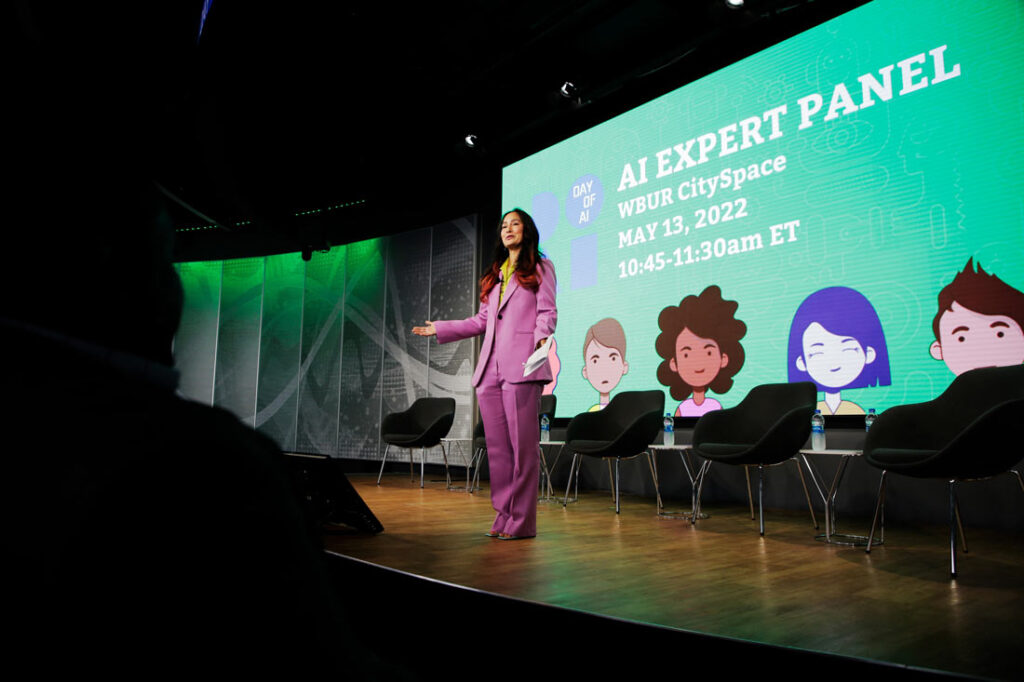Unlike with previous generations, students today are learning early on how to collaborate with emerging technologies and artificial intelligence to shape the world they want to live in as adults.
Many teachers are also embracing AI, especially when it means they can be more efficient and effective at their jobs. AI enables teachers to streamline administrative tasks, drive efficiency and fill gaps where they need a little help, such as adapting lessons to individual learning needs in a classroom of 30-plus kids. Yet, despite all these technologies, the unique skills that come naturally to us as humans—emotional intelligence, empathy and social awareness to name a few—still reign supreme.
With more than two decades of experience in AI, American robotics scientist and entrepreneur Cynthia Breazeal, Ph.D., is a world-renowned pioneer and lead researcher of social robotics and human-robotics interaction. In 2004, she published her seminal book, Designing Sociable Robots, which presented her vision for social robots of the future. Breazeal later co-founded Jibo, a company that developed personal assistant robots in 2012. A true innovation of its time, the Jibo robot was friendly and designed to be part of the family. It featured cameras and microphones, responded to questions and even recognized faces.
Cynthia Breazeal witnesses a shift in perspectives on AI
Today, Breazeal is a professor of media arts and sciences at Massachusetts Institute of Technology, where she founded and directs the Personal Robots group at the institution’s Media Lab. She is also the MIT dean for digital learning and the director of the MIT-wide Initiative on Responsible AI for Social Empowerment and Education (MIT RAISE), an initiative that works toward making advanced tech innovation accessible to younger generations and future entrepreneurs and innovators.
Over the past 20 years, Breazeal has seen a perspective shift in how people approach and perceive AI. Whereas the focus used to center around cognitive decision-making and navigation, technologies are now leaning into the innately human skills that have been overlooked because they come so naturally to us. “We are incredibly socially and emotionally sophisticated, and these are our superpowers as a species,” she says, adding that everything we know about our society, from the things we’ve built and created, all comes from our social-emotional intelligence and collaboration.
Using the examples of recent advances like Alexa and ChatGPT, Breazeal describes these technologies as social interfaces, or personified AI systems, that don’t present themselves as a tool. “They present themselves as an ‘other’—a social ‘other’—and a lot of human social-emotional psychology comes along for that ride,” she says. At the same time, Alexa is very transactional, and ChatGPT is session per session; these technologies don’t really know you.
AI for social good
Much of Breazeal’s more recent work focuses on the long-term impact of social robots on everyday life—a theme she refers to as “living with AI”—and how social robots can build relationships and provide personalized support in whatever functions they are serving. She hones in on what it really means to create an AI system that significantly contributes to human flourishing. “It’s something that actually helps us to become who we aspire to be, that helps us with profoundly human things like being healthier, aging with greater independence, learning new skills and upskilling,” Breazeal says. These are all transformative capabilities that, when acquired, can enhance one’s life and open up opportunities that wouldn’t be available otherwise.
“These are areas where our social and emotional intelligence are really tightly bound into how effective these interventions are for us, and if we can’t engage our emotions, or we can’t engage socially with a sense of community and meaning, we’re not as successful,” she says.
Breazeal uses this approach when deploying different types of social robots for evaluation. “We were seeing how people were engaging with them, and [we realized how socially persuasive they are],” she says. She compares the effect these robots had as similar to that of a human coach or a tutor. “We started looking at long-term interaction, where you were actually living with this robot, like in ‘Star Wars,’ [where these systems get to know you].”
Cynthia Breazeal has a breakthrough
Some of her greatest insights occurred during the COVID-19 pandemic. At the time, Breazeal just happened to be deploying a type of social robot that acted almost like a wellness or positive psychology coach. “We were sending these little social robots out into the homes of people all across the country, during a time when there was social distancing and isolation, and the responses we received were profound,” she says. Especially for older adults living alone, simply having an entity acknowledging their presence positively benefited their emotional well-being and mental health. “Chronic loneliness is a huge issue in this country; these are areas where the need for skilled professional services is far outpacing our ability to train professionals to meet these demands,” Breazeal says.
The pandemic also had a huge impact on kids’ learning and mental health. As Breazeal points out, it showed us how it’s not enough to rely on teachers and the current professional staff to address this growing, overwhelming need. “We need the right kinds of tools and technologies that are both professional facing as well as main user facing that extends and augments and helps provide an elevated quality of care that’s much more scalable and affordable,” she says.
Artificial intelligence for kids: Teaching AI literacy in schools
In her work for MIT RAISE, Breazeal aims to make education around AI and other advanced technologies more accessible—as well as approachable—to younger generations. “We want to help prepare young people to be able to enter into this workforce successfully,” she says, stressing the importance of understanding AI’s social implications as well as the ethics and responsibility required. “People spend a lot of time and money and expertise to build these things to actually do something specific,” she says.
Breazeal hopes that through early introductions of AI for kids and hands-on learning, the younger generation will see firsthand the value of working with AI rather than against it. “Collaborating allows us to elevate human creativity, elevate our ability to solve complex problems and elevate our ability to connect,” she says. As she sees it, the goal of AI goes beyond its efficiency or cost-effectiveness; the real design value is in our ability to collaborate with these technologies.
“We need to design these systems so that they can be much more steerable, much more intuitive to use to empower a much broader part of society… to be able to apply our human values and expertise to shape our future harnessing this technology.”
Day of AI is changing AI for kids around the world
In an effort to increase AI literacy among younger generations as well as educators, Breazeal and her team developed Day of AI, a program that takes place every May (2024 will be its third run), which features hours of hands-on activities that educate kids about AI. Through creative discovery, discussion and critical thinking, kids have fun while learning—and experiencing—the fundamentals of AI.
To date, Day of AI has reached people in more than 114 countries, with 10,000 educators downloading the curriculum and teaching it in their classrooms. “We do a lot of research around understanding how teachers across subject matter, expertise and grade bands are engaging with their students,” Breazeal says. “We’re seeing some really amazing results in terms of not just how teachers feel they are prepared and can adapt this curriculum to their students, but [how the hands-on component] makes students feel more empowered.”
There’s definitely an emotional element to this arc of learning. The more students learn and interact with artificial intelligence for kids, the more they feel that they have a voice in this future. “Once they feel they have a voice and that they can shape it, now they have optimism, and they have hope,” Breazeal says.
Day of AI at a glance
Early Elementary
Grades K-2 / Ages 5-7
Proving that you’re never too young to learn, this curriculum covers the basics of AI. This includes what AI is, how it shows up in pop culture and how it can be used in both positive and negative ways. Students then get to design their very own robot for social good.
Upper Elementary
Grades 3-5 / Ages 8-10
Building upon AI fundamentals, the upper elementary track helps students understand how machines can learn to make decisions by looking at datasets, algorithms and predictions. They also discuss ways to ensure that AI does not infringe on basic human rights.
Middle School
Grades 6-8 / Ages 11-13
Students on this talk track cover AI in pictures, music and stories. They learn how to spot deepfakes, a type of AI used to create convincing images, audio and video hoaxes, and how to create their own art using AI. Later, students use the Scratch programming language to create their own computer game with an AI character whose performance improves as it plays.
High School
Grades 9-12 / Ages 14+
High school students dive into AI in social media, learning how the algorithms build recommendations for users. The curriculum also covers data activism and voice AI using Alexa’s AI systems.
High School Computer Science
Grades 9-12 / Ages 14+
Day of AI’s most advanced curriculum covers machine recognition (or “image classification”). There are also opportunities to learn Python programming and an exercise on how to spot biases that come with artificially intelligent machines.
All Grades / Ages 5-18
Available to students of all ages, this intro curriculum introduces ChatGPT and the process it uses to generate human-like dialogue and storytelling. There are also discussion points for whether it should (or should not) be used in schools.
This article originally appeared in the January/February 2024 issue of SUCCESS Magazine. Photo by Jimmy Day/courtesy of MIT Media Lab.




